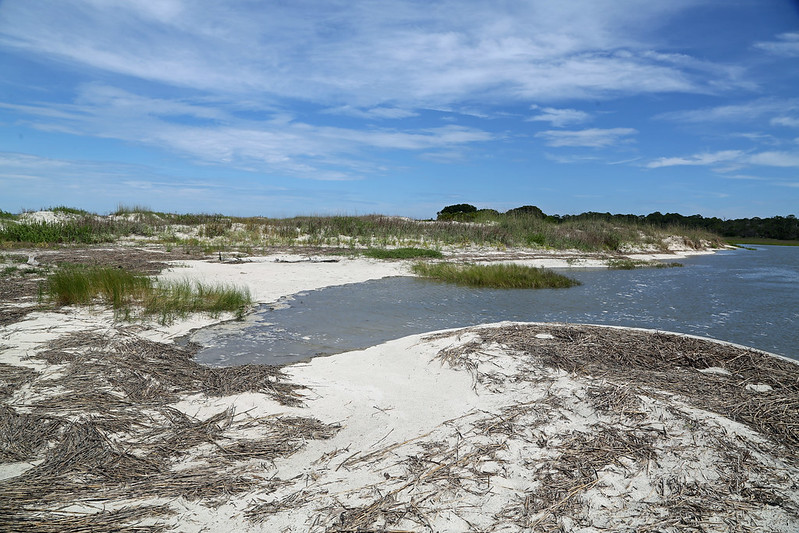
Wassaw Island is the second Georgia barrier island located just south of Tybee Island. It is north of Ossabaw Island. It is a National Wildlife Refuge and was designated on October 20, 1969. The Refuge is 10,053 acres with dunes, live oak and slash pine and salt marshes. There are 20 miles of dirt roads and 7 miles of beach. The island is about 8.5km long and 1.2km wide. It is only accessible by boat and you must use your own boat to reach the refuge. It is open from public from sunrise to sunset.
Geological History
Unlike other Georgia Barrier Islands, Wassaw was formed less than 1,000 years ago. Skidaway Island, which lies inland of Wassaw Island, was a coastal barrier island during the Pleistocene Epoch but the formation of Wassaw Island landlocked Skidaway.
Hurricanes did not affect the barrier islands severely until Hurricanes Matthew (2016) and Irma in 2017. The 1893 Sea Islands Hurricane impacted Wassaw Island by creating an unusually tall coastal sand ridge which is now covered by maritime forest. Additionally, the ridges seen in the maritime forest on the southern tip is indicative of a regressional period of development of Wassaw Island, which means that the island was building seaward at some point. There is a tree boneyard that has been left behind as the long-shore drift and sea level rise erode away the north end of the island and brings sand to the southern tip.
Ecological History
Wassaw Island is a refuge for egret and heron rookeries, wading birds, and loggerhead sea turtles. The salt marsh is home to a large alligator population as well. The ecosystems on Wassaw Island include salt marshes, maritime forests, beaches and freshwater ponds. It is 76% salt marsh and 24% upland, which includes non-salt marsh areas. The salt marsh separates Wassaw Island from Skidaway Island. Wassaw Island is one of the only islands to have never been clear cut for timber. Thus, its upland areas are filled with old-growth maritime forest.
A collaboration between the Savannah Science Museum, the Wassaw Island Trust (founded by the Parsons family who owned the island), and the US Fish and Wildlife Service, the Caretta Research Project was started in 1972. The project monitors the loggerhead sea turtle population on Wassaw island by collecting demographic information. The project protects nests to secure safe incubation and encourage hatchling production. Wassaw Island receives some of the highest densities of loggerhead nests in the state, which is why it is central to the CRP. Since the start of the CRP, they’ve seen an 8-fold increase in Loggerhead nesting. Every year, from mid-May to Labor Day, a two person staff and six volunteers inhabit the island and patrol the beach. To participate in the program, one can pay a $795 fee which covers meals and accommodations in a Parsons cabin.
Human History
There is very little development and management on the island, which can be attributed to both the geological youth of the island which reduces the Native American history on the island as well as limited development by European colonizers. Native American artifacts have been found on the island dating back to 500-600AD
In 1846, 300 slaves were brought from a plantation in Liberty County, GA to die in isolation in attempt to prevent a cholera epidemic. All the slaves are believed to have died and were buried in unmarked graves.
Little Wassaw Island is the only island owned by a formerly enslaved Black person. Anthony Odingsell was given Little Wassaw Island by his owner, Charles Odingsell, along with nine slaves who were to work the land. The proceeds from the land were intended to fund Anthony’s education. In 1860, Anthony Odingsell owned 2,000 acres of land, 13 slaves, 35 cows, 50 sheep, and 75 pigs. He died January 15, 1878 at the age of 94, surviving both the Civil War and Reconstruction. He held onto Little Wassaw throughout this period.
During the Civil War, the island was occupied by Confederate and Union troops. Cannon balls have been found along the northern end along with an unmarked soldier’s grave.
During the Spanish American War of 1898, Battery Morgan was built on the northern tip to protect Savannah. It was originally located in the coastal dunes but longshore drift and sea-level rise have relocated the ruins of the Battery over 50m offshore.
George Parsons, born in 1826 in Maine, was a businessman with dealings in southern cities including Savannah. He purchased Wassaw Island in 1866 as a bridal gift for Sarah Eddy Parsons. A family compound was built in the center of the island. Guided by conservation interests, the family sold Wassaw Island to the Nature Conservancy of Georgia for $1 million under three conditions: 1) the island would remain in its natural state 2) no bridge would connect it to the mainland 3) 180 acres would be retained by the Parsons family including the housing compound.
Bibliography
About the Refuge – Wassaw – U.S. Fish and Wildlife Service. (n.d.). Retrieved from https://www.fws.gov/refuge/Wassaw/about.html
Background of Caretta Research Project. (n.d.). Retrieved from https://www.carettaresearchproject.org/background
Johnson, W. B. (1980). Free Blacks in Antebellum Savannah: An Economic Profile. The Georgia Historical Quarterly, 64(4), 418–431. http://www.jstor.org/stable/40580706
Lenz, J. (2018, March 06). Wassaw Island, The Caretta Research Project, and a 150 Year Family Legacy of Philanthropy. Retrieved from https://stewardsofgacoast.org/2016/11/15/wassaw-island-the-caretta-research-project-and-a-150-year-family-legacy-of-philanthropy/
Wassaw Island. (n.d.). Retrieved from http://georgiacoastatlas.org/wassaw-island.html